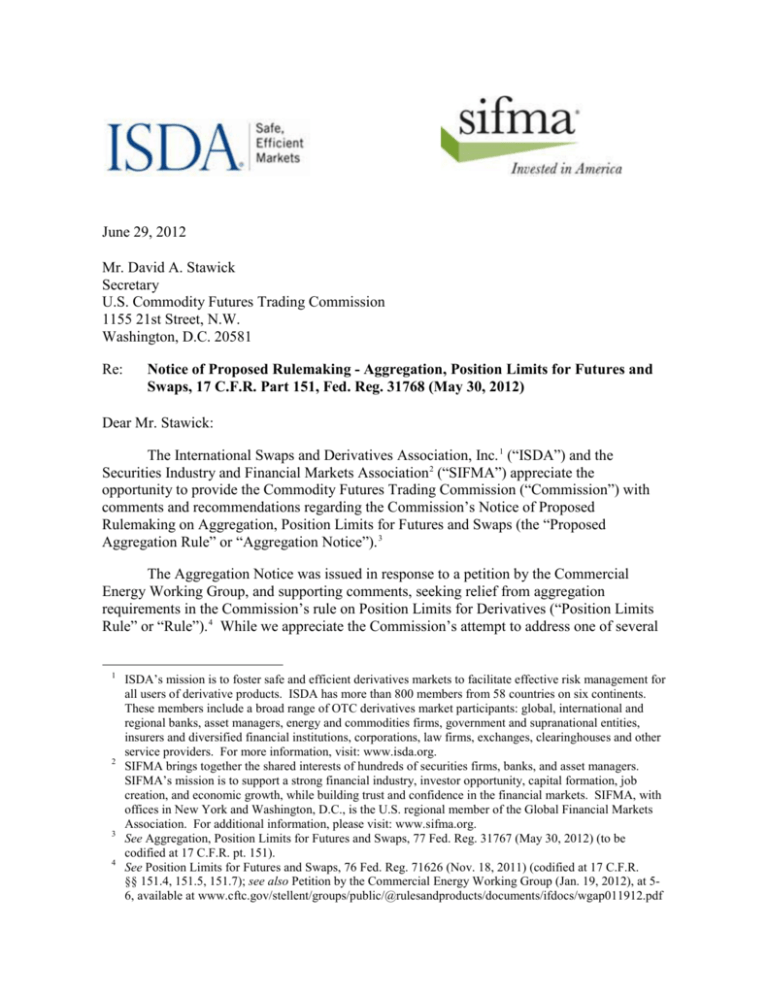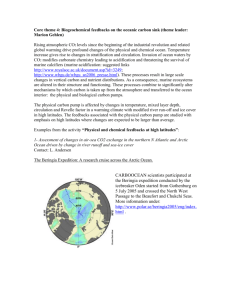ISDA SIFMA Aggregation Comment Letter
advertisement

June 29, 2012 Mr. David A. Stawick Secretary U.S. Commodity Futures Trading Commission 1155 21st Street, N.W. Washington, D.C. 20581 Re: Notice of Proposed Rulemaking - Aggregation, Position Limits for Futures and Swaps, 17 C.F.R. Part 151, Fed. Reg. 31768 (May 30, 2012) Dear Mr. Stawick: The International Swaps and Derivatives Association, Inc. 1 (“ISDA”) and the Securities Industry and Financial Markets Association 2 (“SIFMA”) appreciate the opportunity to provide the Commodity Futures Trading Commission (“Commission”) with comments and recommendations regarding the Commission’s Notice of Proposed Rulemaking on Aggregation, Position Limits for Futures and Swaps (the “Proposed Aggregation Rule” or “Aggregation Notice”). 3 The Aggregation Notice was issued in response to a petition by the Commercial Energy Working Group, and supporting comments, seeking relief from aggregation requirements in the Commission’s rule on Position Limits for Derivatives (“Position Limits Rule” or “Rule”). 4 While we appreciate the Commission’s attempt to address one of several 1 2 3 4 ISDA’s mission is to foster safe and efficient derivatives markets to facilitate effective risk management for all users of derivative products. ISDA has more than 800 members from 58 countries on six continents. These members include a broad range of OTC derivatives market participants: global, international and regional banks, asset managers, energy and commodities firms, government and supranational entities, insurers and diversified financial institutions, corporations, law firms, exchanges, clearinghouses and other service providers. For more information, visit: www.isda.org. SIFMA brings together the shared interests of hundreds of securities firms, banks, and asset managers. SIFMA’s mission is to support a strong financial industry, investor opportunity, capital formation, job creation, and economic growth, while building trust and confidence in the financial markets. SIFMA, with offices in New York and Washington, D.C., is the U.S. regional member of the Global Financial Markets Association. For additional information, please visit: www.sifma.org. See Aggregation, Position Limits for Futures and Swaps, 77 Fed. Reg. 31767 (May 30, 2012) (to be codified at 17 C.F.R. pt. 151). See Position Limits for Futures and Swaps, 76 Fed. Reg. 71626 (Nov. 18, 2011) (codified at 17 C.F.R. §§ 151.4, 151.5, 151.7); see also Petition by the Commercial Energy Working Group (Jan. 19, 2012), at 56, available at www.cftc.gov/stellent/groups/public/@rulesandproducts/documents/ifdocs/wgap011912.pdf June 29, 2012 Page 2 serious deficiencies in its Position Limits Rule, it must be recognized that the Proposed Aggregation Rule purports to amend only a portion of a rule that is fundamentally flawed. 5 The Position Limits Rule establishes the commodities and positions that will be aggregated, and the limits under which the Proposed Aggregation Rule will operate, but it was promulgated without finding that position limits were necessary or appropriate and without conducting an adequate cost-benefit analysis. The persistent substantive and procedural flaws in the Position Limits Rule necessarily affect the proposed aggregation amendments. Moreover, while the Aggregation Notice is a positive step in the Commission’s consideration of position limits, it continues to impose unnecessary burdens and to rest upon a misunderstanding of the Commission’s statutory responsibilities. We will leave it to other commenters to offer detailed critiques of the substance of the Proposed Aggregation Rule. Instead, our comments focus on the persistent flaws in the Commission’s related Position Limits Rule, and to certain significant shortcomings in the Proposed Aggregation Rule. I. Introduction As the Commission is aware, the Position Limits Rule imposes limits on futures and options contracts in 28 exempt and agricultural commodities and their economically equivalent swaps. The Rule also includes provisions that dictate when a trader must aggregate positions held in multiple accounts for the purpose of complying with position limits.6 For example, under the Rule, a trader must aggregate all accounts in which it holds directly or indirectly at least a 10% ownership interest. 7 As the Working Group Petition observed, the Position Limits Rule unexpectedly eliminated the proposed “owned nonfinancial entity” (“ONF”) exemption, which would have exempted ownership of nonfinancial entities from the Rule’s aggregation requirements. 8 Consequently, a trader who owns 10% of companies that are engaged in financial or non-financial activities is required to aggregate 100% of those companies’ positions in Referenced Contracts with its own holdings 5 6 7 8 (hereinafter, “Working Group Petition”); see also Futures Industry Association Comment (Mar. 26, 2012), available at http://www.cftc.gov/stellent/groups/public/@rulesandproducts/documents/ifdocs/fialtr 032612.pdf (hereinafter, “FIA Comment”); Edison Electric Institute and American Gas Association (March 1, 2012), available at http://www.cftc.gov/stellent/groups/public/@rulesandproducts/documents/ifdocs/eeiaga_comments.pdf; Coalition of Physical Energy Companies Comment (February 27, 2012), available at http://www.cftc.gov/stellent/groups/public/@rulesandproducts/documents/ifdocs/copeltrwga022712.pdf (hereinafter, “EEI and AGA Comment”). See Proposed Aggregation Rule, 77 Fed. Reg. at 31769 n.13 (acknowledging that the Proposed Aggregation Rule “deal[s] solely with the aggregation of accounts”). See 17 C.F.R. § 151.7. See id. § 151.7(c)(1). Working Group Petition at 5-6; see also Proposed Aggregation Rule, 77 Fed. Reg. at 31769 n. 25 (acknowledging that the Commission discarded the ONF exemption in its final rule). June 29, 2012 Page 3 for purposes of assessing compliance with position limits. This aggregation is required even if the trader lacks the capacity to control trading in Referenced Contracts by the other companies or—for that matter—the ability to discover the companies’ positions. 9 Though the Commission repeatedly insists that the aggregation provisions in the Position Limits Rule “generally retained the Commission’s existing aggregation policy,” the Commission’s current aggregation requirements differ considerably from their predecessors. 10 For example, the Commission’s new aggregation provisions apply for the first time to a broader swath of commodities and to economically equivalent swap contracts. And the new aggregation rules are not accompanied by the same aggregation exemptions that applied under the previous regime. 11 In addition, and as the Commission acknowledges in a footnote in the Aggregation Notice, the Commission added a new aggregation provision for persons with positions in accounts with identical trading strategies, which applies even if a person has no control over trading and owns less than a 10 percent interest in an account. 12 The Position Limits Rule also curtails the opportunity for bona fide hedging by enumerating an exclusive list of permissible hedges. 13 Under prior law, a party could request approval of a “non-enumerated” hedging transaction from the Commission, but the final Rule eliminated that provision because the Commission determined that section 140.99’s procedure for obtaining interpretive guidance and discretionary exemptive relief was sufficient. 14 The Proposed Aggregation Rule would make five changes to the existing aggregation regime. These amendments include: 1. Expanding the Position Limits Rule’s exemption for aggregation where the sharing of information would violate federal law, 17 C.F.R. § 151.7(i), to circumstances in which information-sharing creates a reasonable risk of violating federal, state, or foreign law. 2. Exempting any trader with a 50% or less ownership stake in another entity from having to aggregate the owned company’s positions, so long as it can demonstrate compliance with five indicia of independence (e.g., that the trader does not have knowledge of the trading decisions of the owned company). 9 10 11 12 13 14 See Notice of Proposed Rulemaking, Position Limits for Futures and Swaps, 76 Fed. Reg. 4752, 4762 (Jan. 26, 2011). Proposed Aggregation Rule, 77 Fed. Reg. at 31769 & n.25. See Working Group Petition at 15. See Proposed Aggregation Rule, 77 Fed. Reg. at 31769 n. 14 (citing 17 C.F.R. § 151.7(d)). See 17 C.F.R. § 151.5(a)(2). See Position Limits Rule, 76 Fed. Reg. at 71648–49; see also 17 C.F.R. 140.99. June 29, 2012 Page 4 3. Expanding the underwriter exemption to the aggregation requirement, 17 C.F.R. § 151.7(g), to include interests acquired through the market-making activities of an affiliated broker-dealer. 4. Exempting higher-tier corporate parents from filing requirements for aggregation exemptions if one of their subsidiaries has already made the requisite filing. 5. Expanding the independent account controller exemption, 17 C.F.R. § 151.7(f), to include commodity pools structured as limited liability companies. (The current regulation applies only to commodity pools structured as limited liability partnerships.) The aggregation provisions that are the subject of the Working Group Petition and the Aggregation Notice are among those that ISDA and SIFMA have challenged in ongoing litigation. 15 The Aggregation Notice proposes changes to 17 C.F.R. part 151 (principally § 151.7) that, if ultimately adopted, would belatedly address two discrete objections that ISDA and SIFMA have raised with respect to the Position Limits Rule’s aggregation provisions, namely the failure to include an exemption for violations of state and foreign law, and the application of the 10% ownership rule as a trigger for aggregation of positions, regardless of the investor’s control. 16 The Aggregation Notice does not, however, propose to make any changes to the core of the Position Limits Rule, including the scope of the commodities covered, the application of position limits to swaps for the first time, and the specific levels at which the limits are set. Nor does it cure any of the fatal procedural defects that led to the Commission’s promulgation of the Position Limits Rule. II. Discussion A. The Commission Still Has Not Properly Determined That Position Limits Are Necessary And Appropriate The Aggregation Notice suggests that the Commission continues to believe that it was required, under the Dodd-Frank Wall Street Reform and Consumer Protection Act’s (“Dodd-Frank Act”) 17 amendment to the Commodity Exchange Act (“CEA”), 18 to “establish 15 16 17 See ISDA/SIFMA v. CFTC, No. 11-2146-RLW (D.D.C.) (filed Dec. 2, 2011). In the Proposed Aggregation Rule, the Commission correctly states that the reasons for permitting an exemption for federal-law violations apply equally to exemptions for violations of state or foreign law, see 77 Fed. Reg. at 31771-72, and acknowledges that the proposal would address “concerns that market participants could face increased liability under state, federal and foreign law,” id. at 31775. This is precisely the argument that ISDA and SIFMA have made in the ongoing position limits litigation before the U.S. District Court for the District of Columbia, and we appreciate the Commission’s efforts to respond to that particular concern. See Dodd-Frank Wall Street Reform and Consumer Protection Act, Public Law 111-203, 124 Stat. 1376 (2010). June 29, 2012 Page 5 limits for futures and option contracts traded on a designated contract market (“DCM”), as well as swaps that are economically equivalent to such futures” without finding that such limits are “necessary” or conducting the appropriate cost-benefit analysis. 19 Since 1936, the Commission’s authority to establish position limits has been circumscribed by a basic statutory standard: The Commission may establish position limits for a given commodity “as [it] finds are necessary to diminish, eliminate, or prevent” “an undue and unnecessary burden on interstate commerce in such commodity” caused by “[e]xcessive speculation.” 20 By its plain terms, this standard requires the Commission to determine (i) that harmful “excessive speculation” exists (ii) with respect to a specific commodity under a futures contract or swap and (iii) that position limits are necessary to diminish, eliminate, or prevent it. In approving the Position Limits Rule, the Commission presented no evidence that excessive speculation is a problem in the relevant markets or that position limits are a necessary, appropriate, or effective way to combat excessive speculation. 21 Indeed, despite the Commission’s readiness to impose position limits and propose new aggregation rules, we are concerned that the Commission continues to lack even a “working definition” of “excessive speculation” or the harm associated with it. 22 Like the Position Limits Rule before it, the Proposed Aggregation Rule does not make any finding that position limits are necessary or appropriate. Indeed, both rules presuppose that excessive speculation is a problem and that aggregation of positions in the manner prescribed is an “appropriate” solution. This approach is inconsistent with the Commission’s statutory authority and ignores numerous studies that have found no discernible evidence of excessive speculation in U.S. commodities markets. 23 18 19 20 21 22 23 See Commodity Exchange Act, 7 U.S.C. § 1 et seq. Id. § 6a(a), 19(a); see also Proposed Aggregation Rule, 77 Fed. Reg. at 31768. Id. § 6a(a)(1). Id. §§ 6a(a)(2), (a)(5). See Tr. of Open Meeting on Two Final Rule Proposals Under the Dodd-Frank Act (Oct. 18, 2011), at 189– 91, available at http://www.cftc.gov/LawRegulation/DoddFrankAct/Rulemakings/ DF_26_PosLimits/dfsubmission7_101811-trans. For example, in March 2009, the Task Force on Commodity Futures Markets of the International Organization of Securities Commissions (“IOSCO”), co-chaired by the CFTC and the United Kingdom’s Financial Services Authority, determined that market fundamentals, not speculation, caused the price volatility in physical commodities markets in 2008. See Task Force on Commodity Futures Markets Final Report, Technical Committee of the International Organization of Securities Commission (March 2009). Similarly, the Government Accountability Office conducted a “review of studies analyzing the impact that index traders and other futures speculators have had on commodity prices” and reported that there is “limited statistical evidence of a causal relationship between speculation in the futures markets and changes in commodity prices.” GAO, Issues Involving the Use of the Futures Markets to Invest in Commodity Indexes (Jan. 30, 2009), at 5, available at http://www.gao.gov/new.items/d09285r.pdf. June 29, 2012 Page 6 The Commission’s failure to determine that excessive speculation exists or that position limits will reduce excessive speculation is a persistent, fundamental flaw in its position limits regulatory regime. No position limits rule should be adopted or enforced in the absence of such a finding. If the Commission is nonetheless determined to move forward with its new position limits rule, it is appropriate that regulatory burdens be minimized to the extent possible, to avoid unjustified costs and interference with market liquidity. For this reason, we consider the Proposed Aggregation Rule to be a positive step forward, but far from sufficient to address the overarching problems with the Commission’s position limits regime. B. The Commission Should Exempt Traders From Aggregating Positions Held By Independently Controlled And Managed Entities, Regardless Of The Traders’ Ownership Interest We agree that the aggregation provisions in the Position Limits Rule must be amended. The current Rule requires aggregation of positions where an investor holds a 10% or greater ownership interest in an entity with positions in Referenced Contracts, even where the owned entity independently trades and manages its positions. We believe that this standard not only imposes unnecessary costs and burdens on market participants but also violates the plain terms of Section 6a(a)(1) of the CEA, which authorize the Commission to require aggregation of positions “held” and “trading done” by an investor with the “positions held and trading done by any persons directly or indirectly controlled” by that investor . 24 Accordingly, under the plain statutory language, “direct or indirect control” of another person is necessary for that person’s holdings to be aggregated with an investor’s directly held positions. The Commission’s existing aggregation standard, however, uses ownership alone as the basis for aggregation, without requiring any evidence of direct or indirect control. Moreover, although the Commission has stated that the purpose of the 10% ownership aggregation rule is to prevent “the sharing of transaction or position information that may facilitate coordinated trading,” the standard it established in the Position Limits Rule is vastly 24 The statute provides: In determining whether any person has exceeded such [position] limits, the positions held and trading done by any persons directly or indirectly controlled by such person shall be included with the positions held and trading done by such person . . . . 7 U.S.C. § 6a(a)(1) (emphasis added). June 29, 2012 Page 7 over-inclusive—forcing aggregation even where an investor is passive or has no knowledge of another entity’s positions, let alone the ability to coordinate trading with that entity. 25 The Commission proposes to amend the aggregation requirements to provide disaggregation relief for traders with a 10% to 50% ownership stake, who undertake to make a notice filing with the Commission demonstrating that the owned entity operates independently under several indicia. 26 Traders who own less than 10% of an entity continue to be exempt from aggregation unless their accounts are commonly controlled or use identical trading strategies, while traders owning more than 50% of another entity are required to aggregate their positions, regardless of whether they exert any control over the owned entity’s trading strategy. While we appreciate the Commission’s apparent effort to tie control to at least a portion of its aggregation requirements for traders owning between 10% and 50% of another entity, we have two principal objections to the proposed disaggregation regime. First, we continue to be concerned by the Commission’s reliance on ownership in excess of 10% as a proxy for control of the owned entity’s investment strategy. The proposed text of the new aggregation rule underscores the Commission’s persistent misreading of the CEA. The Proposed Aggregation Rule states: any person holding positions in more than one account, or holding accounts or positions in which the person by power of attorney or otherwise directly or indirectly has a 10 percent or greater ownership or equity interest, must aggregate all such accounts or positions.27 Again, by emphasizing ownership rather than control, the Commission has ignored the plain terms of Section 6a(a)(1). We continue to believe that treating one entity’s ownership interest in another as tantamount to controlling the other entity’s holdings—and as 25 26 27 Position Limits Rule, 76 Fed. Reg. at 71654. Commissioner O’Malia recognized in his dissent to the Position Limits Rule that the Rule’s aggregation requirement will impose significant costs on market participants—particularly given the inclusion of the much larger swaps market for the first time. “The practical effect of th[e] [aggregation] requirement,” he explained, “is that non-eligible entities, such as holding companies who do not meet any of the other limited specified exemptions will be forced to aggregate on a 100% basis the positions of any operating company in which it holds a ten percent or greater equity interest in order to determine compliance with position limits.” Position Limits Rule, 76 Fed. Reg. at 71,704. “[B]y requiring 100% aggregation based on a ten percent ownership interest, the Commission has determined that it would prefer to risk double-counting of positions over a rational disaggregation provision based on a concept of ownership that does not clearly attach to actual control of trading of the positions in question.” Id. See Proposed Aggregation Rule, 77 Fed. Reg. at 31773-74. Proposed Aggregation Rule, 77 Fed. Reg. at 31782 (quoting proposed Section 151.7). June 29, 2012 Page 8 indistinguishable, in effect, from the entity holding positions in its own name—runs afoul of well-established principles of corporate separateness. There is simply no reason to believe that ownership of an entity is synonymous with control over the owned entity’s investment strategy. As an example, for traders that hold more than 50% of a company, it is not the case that investments “held” by a subsidiary are necessarily “held” or controlled by the subsidiary’s parent. Accordingly, we believe that it is inappropriate for the Commission to presume that owned entities are necessarily controlled by their owners, absent evidence of information-sharing and control. Second, and relatedly, we believe that requiring traders owning 50% or less of an entity to make notice filings to demonstrate their compliance with certain indicia of independence is unduly burdensome. 28 It is reasonable, we believe, to require aggregation of another entity’s holdings when a trader both owns 10% or more of the other entity and directly or indirectly controls the entity’s holdings (or trading). Control should not be presumed from ownership alone. If, however, the Commission believes that there must be some level of holdings beyond which a presumption attaches, then at most it should presumptively require aggregation when a trader’s ownership interest exceeds 50 percent, and the trader should be given the opportunity to rebut that presumption and avoid aggregation by making a filing which demonstrates that its holding is passive, and there is no control or coordination of holdings. Though we continue to believe that the position limits that form the foundation for the proposed aggregation amendments were arbitrarily imposed, we generally support the Proposed Aggregation Rule’s exemption for aggregation and information-sharing that presents a reasonable risk of violating federal law, state, or foreign law. We believe it is noteworthy, however, that the Commission appears to be increasing the possibility of such violations by requiring information-sharing between entities that would not normally share such information, thereby creating potential issues under the securities and antitrust laws. In addition, we continue to believe that an owned non-financial entity exemption for individuals and entities owning any percentage of another entity is appropriate. Finally, we believe it is unduly burdensome to require market participants seeking aggregation relief to obtain opinions of outside counsel concerning likely violations of law. We encourage the Commission to accept legal opinions from internal counsel and to permit market participants to submit and rely on the opinions of industry association lawyers. In sum, we encourage the Commission to require aggregation only of positions that are “held” and “directly or indirectly controlled,” and we support an owned non-financial entity exemption, as proposed in the Working Group Petition, for all traders. We believe that the notice filing system, as proposed, is unduly burdensome for traders owning 50% or less 28 See Proposed Aggregation Rule, 77 Fed. Reg. at 31773-74. June 29, 2012 Page 9 of another entity. If the Commission insists on imposing a notice filing regime to afford disaggregation relief to traders, that regime should, at most, apply to traders who own more than 50% of another entity. C. While The Proposed Aggregation Rule Is A Positive Step, It Does Nothing To Correct Numerous, Significant Deficiencies In The Related Position Limits Rule The Aggregation Notice, if it eventually results in a final rule that amends the Position Limits Rule, would be a step in the right direction. But it would do nothing to fix the serious flaws at the heart of the Position Limits Rule, including the Commission’s failure to find that position limits are “necessary” and “appropriate,” the Commission’s cursory cost-benefit analysis, and the Commission’s failure to substantiate vague appeals to administrative experience instead of offering substantive analysis of the connection between the evidence in the record and the decisions the Commission made. Even if the Commission puts in place a less draconian aggregation standard, it has still failed to offer a reasonable explanation for the need for position limits for the specific commodity contracts it chose to regulate and why the particular levels it selected were necessary and appropriate. Indeed, the Proposed Aggregation Rule does nothing to correct the following problems in the Position Limits Rule: 1. The Commission’s Position Limits Rule more than tripled the types of commodities subject to position limits without finding that any of those limits are necessary or that they will be effective in preventing excessive speculation. 2. The Position Limits Rule establishes a spot-month position limit equal to 25% of “deliverable supply,” 17 C.F.R. § 151.4(a), but does so merely on the basis of its purported “experience.” 29 The Commission could not have determined that this level “worked well” in the past because it had never imposed this limit on the swaps market, and it did not attempt to estimate whether the preexisting limits had curtailed excessive speculation or imposed economic costs. 30 3. The Commission asserted that the non-spot-month limits formula—10% of open interest for the first 25,000 contracts and 2.5% thereafter—was justified because it was allegedly “consistent with the Commission’s historical approach to setting non-spot-month speculative position limits.” 31 But the Commission could not know whether that 29 30 31 See Position Limits Rule, 76 Fed. Reg. at 71634. Id. at 71634. Id. at 71639. June 29, 2012 Page 10 “historical approach” was effective, because it took no steps to examine whether it prevented excessive speculation and ignored studies showing that it did not. Nor did the Commission have “experience” to draw upon because the 20 commodities not previously subject to Commission-set limits were generally subject to more flexible accountability levels by the exchanges, and swaps had never been subject to position limits or accountability levels. 4. The Commission elected to subject swaps to the same position limit formulae that it has historically applied to futures and options contracts, even though the term “swap” has not yet been defined, and the Commission conceded it lacks sufficient data on swaps to evaluate the necessity for position limits or their economic costs. 32 5. The Commission did not meaningfully justify the circumscribed scope of the bona fide hedging exemptions in the Position Limits Rule. Most egregiously, the Commission eliminated the preexisting option for parties to ask the Commission to recognize a “nonenumerated” hedging transaction. The Commission justified this decision on the ground that parties could still seek “interpretive guidance” under 17 C.F.R. § 140.99 as to whether the proposed transaction fit within one of the enumerated hedges, or could petition to amend the regulations. Commissioner Sommers called these processes “cold comfort,” noting that “none of [them] is flexible or useful to the needs of hedgers in a complex global marketplace.” 33 6. The Commission did not seriously assess the possibility that the Position Limits Rule will cause market participants to flee to foreign markets. 34 The Commission cited two studies that were each more than a decade old and briefly noted its participation in an international organization intended to develop regulatory principles—a fact that has no bearing on whether the adopted Rule will lead to a flight of investors from U.S. markets. 35 These flaws persist in the Position Limits Rule and will not be remedied by the Proposed Aggregation Rule. 32 33 34 35 Id. at 71671 n.432. Id. at 71700. Id. at 71658–59. Id. at 71659. June 29, 2012 Page 11 III. Conclusion The Commission’s failure to establish that position limits are necessary and appropriate rendered the Position Limits Rule fundamentally flawed. The Position Limit Rule should be withdrawn. If, however, the Commission is determined to leave the Rule in place, the Proposed Aggregation Rule is an appropriate initial step toward reducing some of the Position Limits Rule’s unnecessary burdens, subject to the revisions outlined above. We appreciate the opportunity to provide these comments and stand ready to provide any assistance in this process that might be helpful to the Commission. Sincerely, _____________________________ Robert Pickel Chief Executive Officer ISDA ____________________________ Kenneth E. Bentsen, Jr. Executive Vice President Public Policy and Advocacy SIFMA





